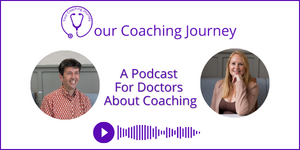‘What is the Person-Centred Approach to Coaching?
The person-centred approach to coaching is what underpins almost all the coaching that people do. If you’ve had coaching or who have undertaken some coach training you will recognise some or all of the elements described here, even if you’ve never heard it described as person-centred coaching.
If people describe themselves as a non-directive coach, the person-centred approach is what they will be using. The phrase non-directive started with a therapist called Carl Rogers, who was active in the middle part of the last century. He took a humanistic approach to therapy and he coined the phrase non-directive to describe what he was doing, because he wasn’t trying to direct his patients; he was trying to draw answers out of them. He actually moved away from the phrase ‘non-directive’ and started calling it person-centred because he felt non-directive was a bit negative, trying not to do something. But it has obviously carried on within the coaching world that we’re trying not to direct our clients. We are using a person-centred approach when we are looking at their agenda and trying to draw the answers to the problems they have out of them rather than just giving them the answers.
What are the Defining Elements of this Approach?
We would say the defining element in this approach is the space that exists within the coaching conversation. It’s all about really good listening, empathy, leaving lots of time and space for the client to do really good thinking.
Carl Rogers, in his work, never really asked any questions. He would introduce a therapy session by saying, “I’m curious to know what it is you’d like to talk about”. And then throughout his therapy, he would just play back what was being said by the patient.
In coaching, that’s a great way to be. If we can listen to what’s being said, offer that space for people to talk, and once they finish talking, play back in some way; we might summarise or repeat back a certain word. Within that space, they have the time to think.
We’re offering our coachees more time to think and more opportunity to reflect on what’s just been played back to them, because they may not be aware of what they’ve just said.
One of the biggest problems for coaches learning to coach, is getting lost in thinking about what the next question might be. This means that they’ve suddenly stopped listening to the person in front of them because they’re thinking, ‘oh, my God, I’m going to have to ask another question’. Whereas if we just focus on listening in order to play back, we can forget about what the next question is and just listen.
Creating Effective Relationships In The Coaching Room
Carl Rogers had the notion that there were six necessary and sufficient conditions to have and effective relationship in the therapy room, and we believe you can say the same for the coaching relationship. (We have adjusted the language in this list to reflect the coaching relationship rather than the therapeutic one)
Carl Rogers’ six necessary and sufficient conditions are:
- Psychological contact; the coaching relationship – This relates to the idea of both client and coach being on the same page about why they are in the coaching room, contracting and consent form part of this. The rapport and trust that you have within the coaching space starts there, nothing can happen without that relationship. The coachee has to trust you. And you have to trust the coachee that they’re being open and honest.
- The client is incongruent – there’s something going on for the client that’s not sitting right with them, whether that’s a problem that they’ve got or a goal that they’ve got that they want to work towards. There’s something going on for them that they want to talk about and it’s their decision to be in the coaching room to discuss it.
- The coach is congruent – to show up as a coach, being ready and willing to listen to the person in front of you, to accept the person in front of you as a complete person capable of doing their own thinking and to hold that space for them. To not to have your own agenda. (If you are an organisational coach, being clear about who your client is in that space and working with the coachee rather than what the organisation might be wanting from the coachee).
- The coach shows unconditional positive regard towards the client – accepting the person for who they are and not sitting in judgement of them, not having an opinion of what they’re doing, but just accepting that is their world.
- The client receives empathy from the coach – understanding why your client might think and feel the way they do, even if it’s different to how you would think and feel in that situation.
- The client perceives acceptance and unconditional positive regard from the coach.
If we can build these elements into our coaching then we’re going to be doing good work.
Elements of The Person-Centred Approach can be Used in any Approach
The person- centred approach really underpins all coaching approaches:
- Listening and leaving space is essential.
- Playing back can be weaved into other approaches whenever we or the client needs clarity on what’s being discussed.
- Using the client’s own language is also a part of person-centred coaching and can be used throughout other methodologies.
When Might This Approach Be Used in the Coaching Room?
The most obvious place for it to be used would be at the beginning of your coaching, when the coachee comes into the room and you want to hear their story. They’ve got something going on in their life that’s not sitting right with them, and they want to let you know about it. That’s a great time to use the person-centred approach and just stay out of the way and let them tell their story.
Once they’ve told their story, we might choose to use a different approach; a solution-focused approach might be more appropriate if we want to move the coachee on. But at the beginning of the session, it’s really about letting them just talk.
Many doctors will have come across this approach, this twin track approach in motivational interviewing. The idea of motivational interviewing is that you allow the coachee to talk about their situation, perhaps, they want to give up smoking. They’ll tell you all about that and what’s going on for them around it, and then there comes a point in that consultation where you assess their readiness for change and whether they really want to affect change. Then you might well move on to a solution-focused approach. In a medical setting, it could be that you have a number of options that you share with them; patches, vaping, group therapy, hypnotherapy. Then you would ask something like, ‘which one do you think you prefer?’ We’re not going to do that in the coaching room because that’s about offering solutions. We are going to ask the coachee what options they have. And draw the options out of them.
When the conversation needs to be more future-focused; the storytelling is done and we want to think about options and moving forward, that’s when we may want to move away from the very person centred approach. That’s when moving through a coaching framework like TOMSCODE is useful. The first part, up to ‘Situation’ would easily lend itself to a person centred approach, but we can switch the conversation to a more future focussed discussion with ‘Change’. We can still explore this with our client in a person-centred way, with lots of space and playing back, but we move away from story telling, and in to a future focussed conversation.
It’s going to be a judgement call on the part of the coach as to how they continue, whether they use a solution focussed approach, or something else, but we’re not therapists and we’re not going to sit week after week listening to the story around the situation hoping that something shifts. Coaching is about encouraging people to move forward. So there are times when we will want to do something different.
The Person Centred Approach to coaching very much underpins our Transformational Coaching Diploma programme. We also explore other approaches that can be weaved in to the coaching sessions to help move clients forward in their thinking. You can find out more about our Transformational Coaching Diploma and the approaches we cover here.



